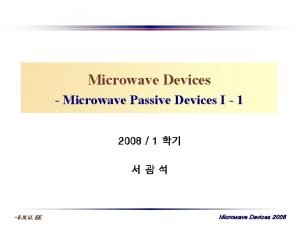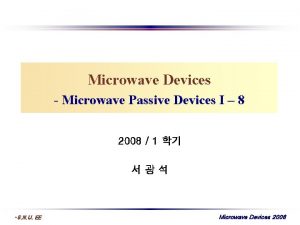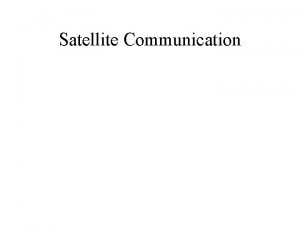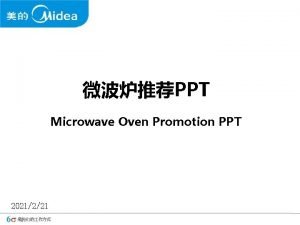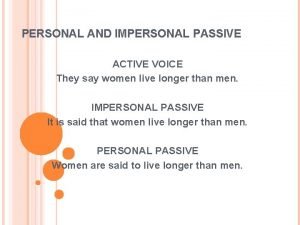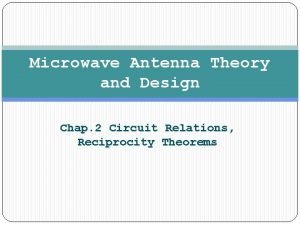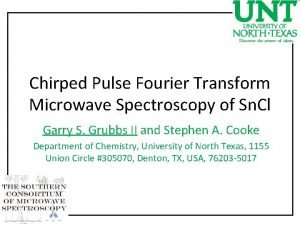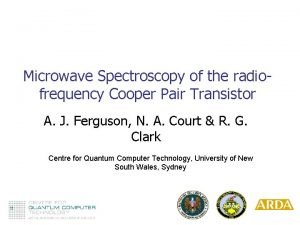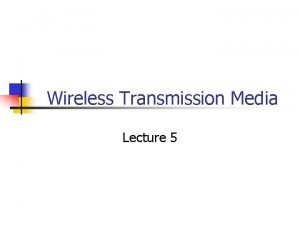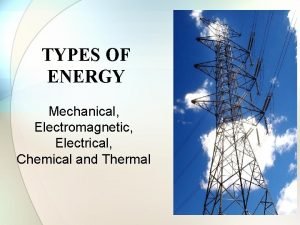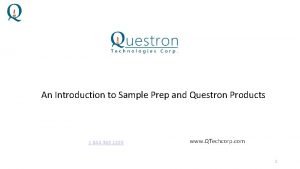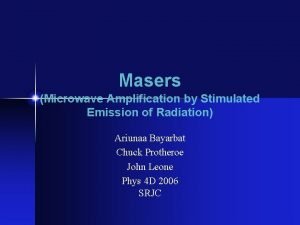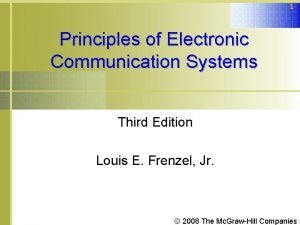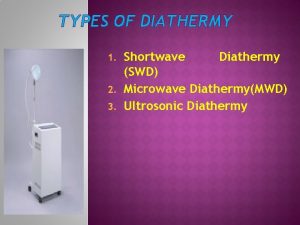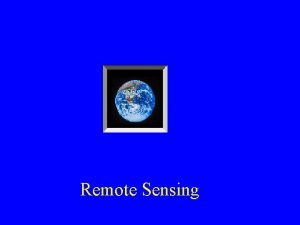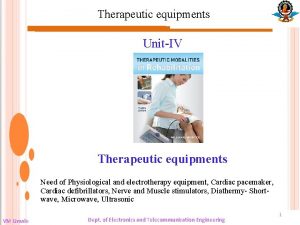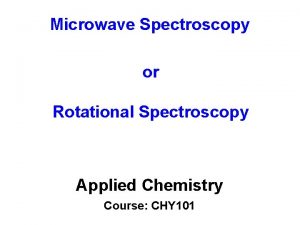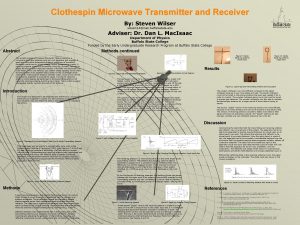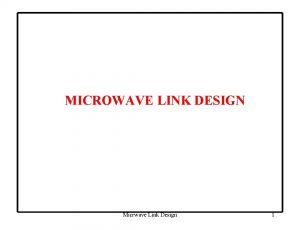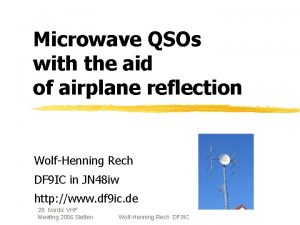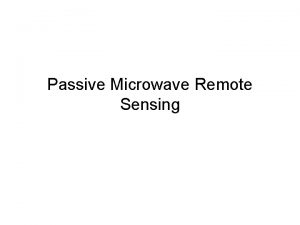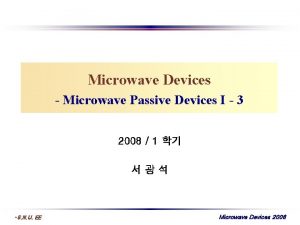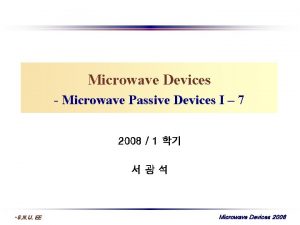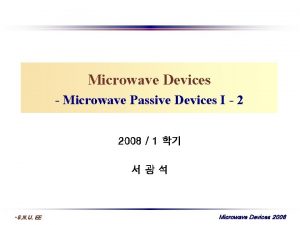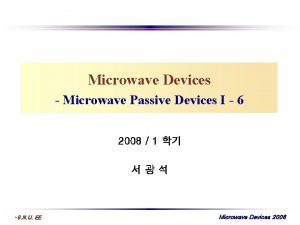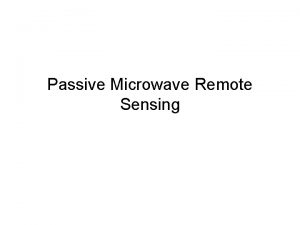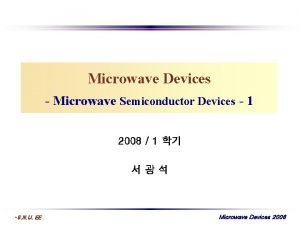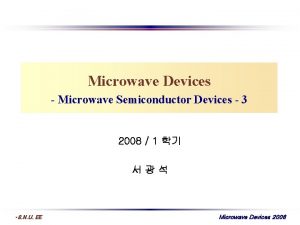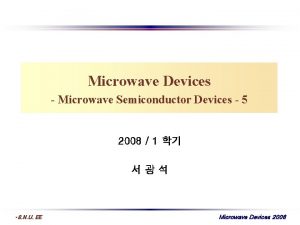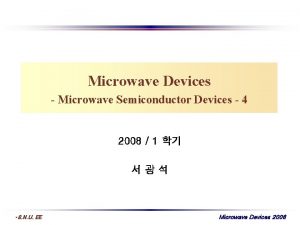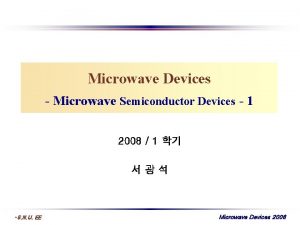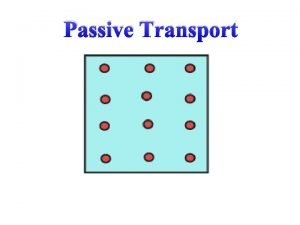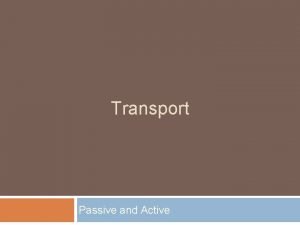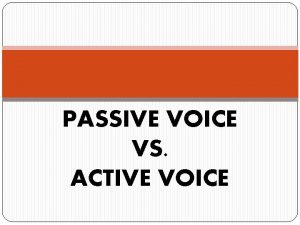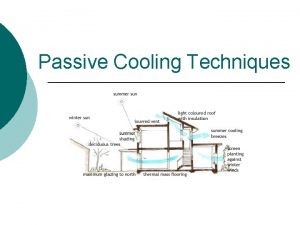Microwave Devices Microwave Passive Devices I 4 2008

























![Future Directions of LTCC Technology Parameter 1998 2003 2009 Min. via size [μm] 250 Future Directions of LTCC Technology Parameter 1998 2003 2009 Min. via size [μm] 250](https://slidetodoc.com/presentation_image_h2/0b4b280e62409c0847299affccbf09f1/image-26.jpg)






- Slides: 32

Microwave Devices - Microwave Passive Devices I - 4 2008 / 1 학기 서광석 • S. N. U. EE Microwave Devices 2008

Multi-Level Metal Inductor on Ga. As ; M/A-COM t 1= t 2= 4. 5 m, d 1= 3 m, and d 2= d 3= 7 m Properties of Polyimide 2. 5 turn, Di= 210 m circular inductor polyimide ( m) Lt (n. H) Peak Qeff Fres (GHz) 0 2. 35 31. 1 11. 8 3 2. 41 35. 5 13. 15 10 2. 26 53. 7 14. 3 Ref. ) I. J. Bahl, IEEE Trans. MTT, p. 654 -664, Apr. 2001 • S. N. U. EE Microwave Devices 2008

High Q Inductor with MCM-D Technology ; IMEC Properties of BCB Ø dielectric constant 2. 6 Ø loss tangent 0. 002 @ 10 GHz Ø dielectric strength 530 V/ m (http: //www. dow. com/cyclotene) - 5 LM Cu damascene BEOL process using 20 - cm Si wafers - BEOL Cu layers (M 1–M 5, have a thickness of 625 nm and an interlevel dielectric of 475 nm. Ref. ) G. J. Carchon, et al, IEEE Trans. MTT, p. 1244 -1251, Apr. 2004 • S. N. U. EE Microwave Devices 2008

High Q Inductor with MCM-D Technology (II) Ref. ) G. J. Carchon, et al, IEEE Trans. MTT, p. 1244 -1251, Apr. 2004 realized in M 4/M 5 with M 3 underpass flow-1 (- -) flow-2 Measured inductor performance for flow-1 and flow-2 with a M 5 BEOL underpass used in parallel with a WLP-M 2 overpass Measured Q factor of a 2. 3 -n. H inductor (L 5) with a patterned polysilicon ground shield underneath the inductors • S. N. U. EE Microwave Devices 2008

High Q MCM-L Inductor Dupont Vialux dielectric constant of 3. 3 - loss tangent of 0. 015 @ 1 GHz - N 4000 -13 dielectric constant of 3. 7 - loss tangent of 0. 015 @ 1 GHz - Ref. ) V. Govind, et al, IEEE Trans. Advanced Packaging, p. 79 -89, Feb, 2004 • S. N. U. EE Microwave Devices 2008

Inductors with SOP Technology with LCP (5 mil width inductor) Ref. ) M. M. Tentzeris, et al, IEEE Trans. Advanced Packaging, p. 332 -340, May, 2004 • S. N. U. EE Microwave Devices 2008

Advanced MEMS Inductor Structures Ø differential inductor 구조 • S. N. U. EE Ø micromachined inductor 구조 Microwave Devices 2008

CMOS Compatible High-Q Air-Gap Solenoid Inductor Ref. ) C. S. Lin, et al, IEEE Electron Device Letters, p. 160, Mar. 2005 • S. N. U. EE Microwave Devices 2008

Simulating Spiral Inductors Full 3 -D electromagnetics solvers can be used to simulate spiral inductors, e. g. FDTD simulators like Fidelity or EMPIRE, FEM simulators like HFSS, or custom code - however, significant time and computer memory needed Planar simulation software more suited - e. g. method of moments simulators like IE 3 D or Momentum Faster (but slightly less accurate) solution: dedicated spiral inductor software that incorporates the simple equivalent model, and calculates Q - ASITIC : Very fast, good for initial design Analysis and simulation tool for spiral inductors and transformers for ICs n Developed by Ali M. Niknejad at UC Berkeley n Document: http: //formosa. eecs. berkeley. edu/~niknejad/asitic. html n • S. N. U. EE Microwave Devices 2008

DARPA’s 3 -D Micro. Electromagnetic Radio Frequency Systems (MERFS) Program ( I ) Rohm & Haas’s Poly. Strata. TM photoresist - sacrificial high-aspect ratio photoresist (50 um to 100 um thick) • S. N. U. EE Microwave Devices 2008

DARPA’s 3 -D MERFS Program (II) Table 1. Phase goals of the 3 -D MERFS program • S. N. U. EE Microwave Devices 2008

Various Embedded Capacitor Materials • S. N. U. EE Microwave Devices 2008

Sizing Embedded Capacitors Typical Distribution of Capacitors in Wireless Consuner Equipment Ref. : R. Ulrich, et al. , “Integrated Passive Component Technology” • S. N. U. EE Microwave Devices 2008

Outlook for Embedded Capacitor Technologies Unfilled polymers – thin(2 -10 m) and thick(10 -50 m) reached technology limits at max of 1 n. F/cm 2 useful for replacing smallest caps, some decoupling Polymers filled with ferroelectric particles (Ba. Ti. O 3) might reach 10 - 20 n. F/cm 2 useful for replacing small caps, more close-in decoupling Thin film paraelectrics (Si. Ox, anodized Al 2 O 3, anodized Ta 2 O 5 ; ~100 nm ) much work to be done, can give maybe 300 n. F/cm 2 capable of close-in decoupling balance of high-k, paraelectric (stable) behavior Ferroelectrics (Ba. Ti. O 3, BST, PZT, > 600°C anneal in O 2 after deposition) very promising area, maybe over 5000 n. F/cm 2 high-k very good for close-in decoupling stability problems can be addressed by lowering k look for much progress and new products here Dielectric constant varies strongly with T, frequency, voltage, and thickness. • S. N. U. EE Microwave Devices 2008

Advanced MIM Capacitors for Si RF-IC/MMIC Industry standard is with PECVD Si. N (50 -100 nm) becoming thinner (~20 nm) To make improved capacitors, various approaches have been actively pursued. ¡Improved deposition process for better dielectric quality (breakdown field) - ALD ¡High k dielectric such as Al 2 O 3, Ta 2 O 5, Ti. O 2, Hf. O 2, and mixtures for reduced leakage currents with Al 2 O 3 or Si. O 2 stack ( Ta. Ti. O, Ta. Al. O, Ti. Al. O, etc) ¡ 3 D MIM structure for larger capacitance 3 D MIM Structure Dielectric PECVD Si. O 2 (20 -50 nm) PECVD Si 3 N 4 (20 -50 nm) ALD Al 2 O 3 (20 -50 nm) ALD Ta 2 O 5 (20 -50 nm) 3 D-MIM with 19 nm Al 2 O 3 • S. N. U. EE Capacitance Density 1 n. F/mm 2 (reliability limited) 2 n. F/mm 2 (reliability limited) 3. 5 n. F/mm 2 (reliability limited) 35 n. F/mm 2 Microwave Devices 2008

Advanced Packaging of Passives • S. N. U. EE Microwave Devices 2008

Multichip Module Technology (MCM) or System on a Package (So. P) - System with two or more bare IC or CSP (chip size package) mounted and interconnected on a substrate. - The bare chips mounted with wire bonding, flip chip or TAB bonding - Three types of MCMs: (Embedded Passives) MCM-L ; based on Laminated PCB tecnologies MCM-C ; based on co-fired Ceramic or glass-ceramic thecnologies MCM-D ; formed by Deposited dielectrics and conductors on a base substrate • S. N. U. EE Microwave Devices 2008

SOP Technology with Liquid Crystal Polymer (LCP) * LCP – low cost polymer ($5/ft for 2 -mil single-clad) - very low water absortion * Bonding of copper-clad LCP sheets (315°C high melt) and LCP adhesion layer (290°C low melt) Comparison of Substrate Properties Ref. ) D. C. Thompson, et al, IEEE Trans. MTT, p. 1343 -1352, Apr. 2004 transverse thermal expansion coeff. • S. N. U. EE Microwave Devices 2008

What is LTCC ( I )? Why LTCC (Low Temperature Co-Fired Ceramic) in RF ? LTCC - glass/alumina mixture that sinters at low temperature (< 900°C) ← highly conductive materials required for reducing loss in RF - W in HTCC [High Temperature (~1600ºC) Co-Fired Ceramic, Alumina] - Low-temperature firing (at ~ 850°C) enables the use of Ag, Au, Cu electrode LTCC Materials - Borosilicate glass + Al 2 O 3 (or mullite, cordierite) + organic binder : Al 2 O 3 : 20 -80%, B 2 O 3, Si. O 2: 10 -70% : the borosilicate component was added to the basic HTCC(Al 2 O 3) composition in order to decrease the sintering temperature - The role of Al 2 O 3 (or mullite, cordierite) - increase dielectric constant & strength - The decrease in dielectric constant can be attained by increasing glass content → raw LTCC delivered as a flexible sheet called “green tape” Electrode - Chemical compatibility (Typical material : Ag or Cu) - No interdiffusion between the electrode and LTCC substrate - No delamination due to the shrinkage mismatch and dewetting • S. N. U. EE Microwave Devices 2008

What is LTCC ( II )? Thermal Vias in LTCC (manufactured by Ferro or Dupont) - Thermal conductivity of alumina ~ 100 times of FR 4 (15 -240 W/m°K for HTCC) - Thermal conductivity of LTCC ~ 20 times of FR 4 (2 -6 W/m°K for LTCC) - Thermal vias can be included for heat release (heat pipe approach). • S. N. U. EE Microwave Devices 2008

LTCC (Low-Temperature Co-Fired Ceramic) Process Low Temp. ~850° C • S. N. U. EE Microwave Devices 2008

Air-Cavity LTCC Spiral Inductor * Low loss LTCC dielectric 114 m ( r =7. 4, tan = 0. 001 @10 GHz) * 12 m Ag conductor * 5 layer LTCC block Ref. ) K. C. Eun, et al, Electronic Comp. & Tech. Conf. 2004, p. 1107, 2004 • S. N. U. EE Microwave Devices 2008

Typical LTCC Design Rules Fine-line screen printing (typical LTCC) - Screen-printing typically limited to line widths of about 100 μm - Trampoline screen with high mesh count used for fine-line printing High Resolution Photoimaged Conductors - Line & space min. 40. . . 50 μm, Line width tolerance: ± 2 μm (with high quality exposure mask) - Uniform thickness & Improved line edge definition 35 -40 μm wide fired Ag photoimaged conductors • S. N. U. EE Microwave Devices 2008

LTCC Tape Material Data • S. N. U. EE Microwave Devices 2008

LTCC Transmission Line Microstrip Line Losses Inner layer Methods of Patterning • S. N. U. EE Surface layer co-fire postfire minimal sizes line/space Standard screen printing ● ● 90/100 μm Fine line screen printing ● ● 50/75 μm Photoimageable inks ● ● 50/50 μm Etched screen printed – ● ● ● 25/25 μm Etched thin film layers – ● <20/20 μm Microwave Devices 2008
![Future Directions of LTCC Technology Parameter 1998 2003 2009 Min via size μm 250 Future Directions of LTCC Technology Parameter 1998 2003 2009 Min. via size [μm] 250](https://slidetodoc.com/presentation_image_h2/0b4b280e62409c0847299affccbf09f1/image-26.jpg)
Future Directions of LTCC Technology Parameter 1998 2003 2009 Min. via size [μm] 250 40 - 25 Min. via pitch [μm] 500 125 75 Min. line width [μm] 125 20 15 Min. line pitch [μm] 250 40 30 Line density [cm/cm 2] 40 200 267 Max. module size [cm 2] 130 360 645 Max. working freq. [GHz] 10 38 80 Max. working temp. [°C] 125 160 200 Future Technologies on LTCC • New screens, inks and printing methods for fine line screen printing • Photoimageable LTCC-systems (conductor-, dielectric and resistor- inks and tapes) • Zero-shrinking including cavities and windows • Pressureless lamination • One process step for via forming and filling • Inks/tapes to integrate optical components • S. N. U. EE Microwave Devices 2008

Zero Shrinkage LTCC Heralock 2000 (Zero-Shrinkage LTCC) - SCS - Heralock does not need any constraining layers during lamination or firing. XY shrinkage of 0. 2% ± 0. 03% Z shrinkage of 30. 6% ± 0. 5% SCS PAS • S. N. U. EE Microwave Devices 2008

Inkjet Printing New Solutions for R&D and Feasibility Ø Ø Ø No photolithography No screens Fast turnaround via digital printing Cartridge Price: < US $35, 000 (includes 40 cartridges) precise drop placement +/-10 microns drop volume variation < +/-2% with TDC electronics drop velocity variation < +/-5% without tuning Ref. ) www. dimatix. com • S. N. U. EE Microwave Devices 2008

Flip Chip Bonding (FCB) CPW MMIC m-strip MMIC ~ 650 mm Wire Bonding Ground Via 50 ~ 100 mm [ Wire-Bonding Technology ] Flip-Chip Bump [ Flip-Chip Technology ] Merits of Flip Chip Technology. Short Interconnection Length Better Electrical Performances Repeatability of the Bonding High Yield & Less Tuning Global Bumping and Bonding Cut in assembly costs High Throughput • S. N. U. EE Microwave Devices 2008

Basic Solder Bumping Processes • S. N. U. EE Microwave Devices 2008

Substrate Integrated Waveguide ( I ) – PCB/MCM-L ( Ref : D. Deslandes and K. Wu, IEEE Trans. MTT, Feb. 2003, p. 593 -596) • S. N. U. EE Microwave Devices 2008

Substrate Integrated Waveguide ( II ) ( Ref : B. Liu, et al. , IEEE MWCL, Jan. 2007, p. 22 -24) • S. N. U. EE Microwave Devices 2008
 Passive microwave devices
Passive microwave devices Microwave passive devices
Microwave passive devices 2008 2008
2008 2008 Passive microwave repeater
Passive microwave repeater Microwave oven promotion
Microwave oven promotion Personal passive structure
Personal passive structure Passive voice in present progressive
Passive voice in present progressive Present perfect continuous to passive voice
Present perfect continuous to passive voice To eat au present simple
To eat au present simple Simple present passive voice
Simple present passive voice Devices in literature
Devices in literature Output devices examples
Output devices examples Microwave filter design
Microwave filter design Microwave antenna theory and design
Microwave antenna theory and design Chirped pulse fourier transform microwave spectroscopy
Chirped pulse fourier transform microwave spectroscopy Microwave spectroscopy definition
Microwave spectroscopy definition Microwave transmission media
Microwave transmission media Microwave type of energy
Microwave type of energy Questron microwave digestion system
Questron microwave digestion system Microwave amplification by stimulated emission of radiation
Microwave amplification by stimulated emission of radiation Solar power satellites and microwave power transmission
Solar power satellites and microwave power transmission Microwave communication system
Microwave communication system Swd frequency wavelength
Swd frequency wavelength Microwave remote sensing lecture notes
Microwave remote sensing lecture notes State diagram for microwave oven
State diagram for microwave oven Microwave diathermy block diagram
Microwave diathermy block diagram Spectra of diatomic molecules
Spectra of diatomic molecules Ganap na kabatiran sa kurikulum
Ganap na kabatiran sa kurikulum Microwave transmitter and receiver
Microwave transmitter and receiver Light specteum
Light specteum Microwave link design
Microwave link design Airplane microwave
Airplane microwave Clip art
Clip art
